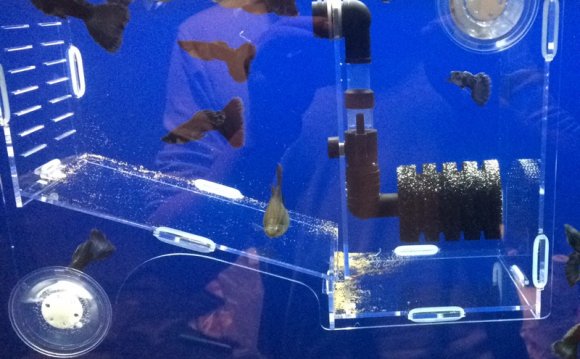
As this species originates from Asia they do well in heavily planted tanks with quite still waters however with lots of space per specimen due to their territorial behaviour which means two or more fish can be raised easily in one aquarium as long as each of them is given at least 40 litres (10.57 US gallons, 8.80 Imperial gallons) of water. Especially males display very territorial behaviour towards each other and the dominant one can bully the weaker one to a complete misery.
In comparison to adult specimens juveniles are very playful and peaceful toward others of the same species, but as they grow up aggression increases which is the reason for having a heavily planted tank when housing Paradise fish as when they don’t see each other, they don’t fight. In addition to plants also add some driftwood into the tank since driftwood naturally divides territories among fish.
In order to ensure your Paradise fish are getting best care it is important to feed them live and or frozen food on a regular basis. Lovers of Guppies won’t agree and may be angry, however giving small Guppies to Paradise fish helps them to live longer. The average lifespan of 2-3 years can be achieved by varying the diet using granules, dried food, frozen bloodworms and live foods as written above.
Tank set-up for Paradise fish
As it has been mentioned above already, Paradise fish come from Asia and therefore planted aquariums are the best option for caring. Since they're known to be very hardy it is OK to keep the general water hardness between 4 and 20°N dGH (71.43 - 357.14 ppm, 1.43 - 7.15 mEq) while pH in tanks with adult specimens should vary between 6 and 7.5. For juveniles it’s better to keep pH at 7 since young fish are more sensitive than adults. Oxygen level in the water isn’t important as these fish can breathe air from surface. Keep KH (carbonate hardness) at 4 at least. KH of anything below 4 definitely is not acceptable as pH will fluctuate and in the end fish will suffer, eventually could get sick or die. Carbonate hardness of 4 is very important when the fry is being cared for.
Height of the tank should be approximately 30 cm (11.81 inches) however Paradise fish don’t necessarily need tall fish tanks and they often lay at the bottom, on plants or on decorations doing nothing but having a rest.
As regards to temperatures it is not recommended to keep this species in ponds during Winter (or cold seasons) unless you're able to keep the temperature in the pond roughly at 16°C (60.80°F). Paradise fish are coldwater fish and thus can stand lower temperatures better than purely tropical fish, and don't need a heater in their tank.
Diet
Adult fish are usually fed once or twice a day however when they eat live foods it's wise to let them starve one day a week as this will clean their digestive system. Feeder Guppies can be given in the amounts of 3-4 specimens per 1 Paradise fish and then wait for the feeders to be eaten before introducing new ones to the tank.
If you feed your Paradise fish granules or other commercial foods make sure fish aren't overfed and the water isn't coloured (this would mean the food contains substances that only colour the whole product while not doing any good to the fish). Uneaten food need to be removed from the tank as such particles often decay and lower the water quality.
Paradise fish will also enjoy having Ramshorn snails in the tank as snails are vital part of their diet.
Bear in mind juveniles usually need food from two to four times a day. The smaller fish, the more often.
Do Paradise fish eat Mystery snails?
Yes. But only when snails are small enough. Later they (fish) just let them be. Paradise fish are also known to eat Ramshorn snails, and I can only agree.
Sexing the Paradise fish
Sexing is quite easy as the female is less coloured than the male. Moreover, females are smaller than males and as usual females are also rounder because of eggs that they produce and carry in their bodies. So if an aquarist have two specimens of which one is smaller, fins are shorter, and colours are not so intensive, it doesn’t automatically mean it’s a male! Always focus on the size of belly. It is very likely one of two males in the same tank will look just like a female except for the size of the belly as the dominant one will harass the weaker one to a certain extent.
Prior to breeding there is the stage of building a nest which doesn't necessarily mean fish are about to breed as it can be a sign of how good he feels in the tank, eventually when a single specimen (male) is kept in the aquarium, he can feel so comfortable that he starts building a bubble nest. Females do not build bubble nests.









